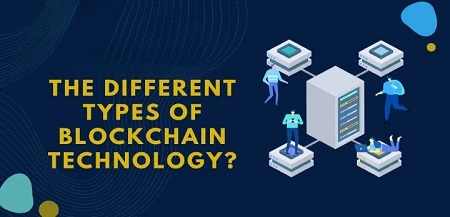Last updated on June 14th, 2023 at 01:38 pm
Introduction
Blockchain works in the same way that the Internet does, with interconnected computers called nodes storing and independently verifying shared data. It is essentially a non-alterable ledger distributed across a network of computers.
Blockchain has three key attributes: immutability, decentralization, and transparency. Data stored on the blockchain is permanent and cannot be changed, making it effective in protecting against malicious manipulation. Furthermore, blockchain networks verify data without relying on a central authority, allowing every computer in the network to access and verify the data.

These unique features of blockchain contribute to its security, making it a tamper-proof technology applicable in various industries. However, despite its diverse applications, the full potential of blockchain technology remains untapped. To fully comprehend its capabilities, it is crucial to understand the different types of blockchain networks and their real-world applications.
This article explores various blockchain networks, their unique attributes, and their practical applications. By examining different network compositions, we gain insight into how blockchain can revolutionize industries and foster innovation.
Types of Blockchain Networks
Blockchain networks are categorized into different types based on their purpose, including private, public, consortium, and hybrid networks. Understanding these types is important to determine their appropriate applications.
1. Public Blockchain

A public blockchain is an open and unrestricted network that can be accessed by any connected node. It operates with a transparent ledger, where transaction records are stored across multiple nodes. Transactions on a public blockchain are visible to all nodes, which can access and verify present and past records, as well as mine new blocks.
Currently, public blockchains are primarily used for cryptocurrency exchanges and the development of decentralized applications (dApps). They can also be used for voting, identity verification, and supply chain management. Examples of public blockchain networks include Bitcoin and Ethereum.
The security of a public blockchain depends on the participants (nodes) in the network. Miners in the Proof-of-Work network (such as Bitcoin) and validators in the Proof-of-Stake network (such as Ethereum) are incentivized to maintain the security of these networks. The more nodes volunteer to secure the network and earn rewards, the stronger its security becomes.
Public blockchains are not controlled by a central authority, making them resistant to single points of failure. To compromise a public network, a malicious actor would need to control at least 51% of the network’s nodes.
Pros of Public Blockchains
- Trustless: Participants don’t need to trust a central authority, as each node can independently verify transactions and detect malicious activity.
- Increased security: The decentralized nature of public blockchains makes it easier to participate in network security while making it harder for hackers to manipulate the network.
- Transparency: Public blockchains distribute copies of the ledger to all connected nodes, ensuring the integrity of the network. All nodes can observe when the ledger is updated, making it difficult for malicious actors to tamper with or override the network.
Limitations of Public Blockchains
- Slower speed: The unlimited number of nodes that can connect to a public blockchain often results in lower transaction speeds compared to other types of blockchain networks. For example, Ethereum processes around 15-45 transactions per second (TPS), while Bitcoin’s maximum is 7 TPS.
- Scalability challenges: Scaling up the number of transactions on a public blockchain network can be challenging due to its slow processing speed.
However, various solutions are being developed to overcome this issue, such as Layer 2 solutions that build additional protocols on existing blockchain platforms. Examples include Bitcoin’s Lightning Network and Ethereum’s Layer 2 solution, Polygon (formerly known as Matic).
- High energy consumption: Public blockchains like Bitcoin require substantial computational power and energy, which raises scalability and environmental concerns.
2. Private Blockchain

A private blockchain is designed for use within a closed environment, where only authorized participants have access. These networks are suitable when there is a need for a central authority to control network activities.
While public blockchains like Bitcoin and Ethereum are open and suitable for cryptocurrency payments and decentralized networks, they may be costly and less secure for private organizations that wish to leverage blockchain’s immutability without exposing confidential data.
Private blockchains are tailored to meet the specific needs of organizations or enterprises that own or control them. Access and usage permissions for the blockchain are granted solely by the organization.
Here’s a brief example of how it works:
If BANK A operates a private blockchain network to store data like customers’ information and transaction records, only authorized employees of this bank will be granted access to the network.
No ‘outsider’ has access to the blockchain, and anyone who needs access must get permission from the network administrator. The number of users is usually limited. The bank may decide to give access to employees of a single branch or all other branches in the city.
Electoral bodies, health institutions, and supply management firms are typical examples of organizations that would use private blockchains.
Examples of private blockchains networks available today are the Hyperledger Fabric and Corda.
Pros of the Private Blockchain
Despite operating within a restricted environment, private blockchains have a number of advantages.
- Increased privacy and security: Private blockchain networks have improved security and privacy as only authorized participants are allowed access to the network.
- Speed: Because a limited number of nodes are connected to private blockchain networks, operations occur at greater speed. Private blockchains typically facilitate between 1,000 to 100,000 transactions per second (TPS). The speed also applies to the addition of data on new blocks.
- Scalability and Customizability: Organizations can tailor private blockchains to their specific needs, including governance rules and consensus mechanisms, and easily add nodes or remove them.
Limitations of Private Blockchain
Below are some reasons why private blockchains may be unfavourable.
- Limited trust: Private blockchains rely on trust among authorized participants, as access is restricted to a select group. Like our example with BANK A above, private blockchains need a central Identity and Access Management (IAM) system with all the monitoring and administrative rights to function optimally.
- Less Security: Because private blockchains have a limited number of nodes, they are prone to security breaches, especially hacking and ransomware. If a malicious actor gains access to the central network, accessing all other computers connected to the network becomes a walkover.
- Centralization: Private blockchains are controlled by a central administrator; this limits the benefits of decentralization offered by public blockchains.
3. Consortium Blockchain

A consortium blockchain network, also known as a federated blockchain network, manages multiple organizations. It functions similarly to a private blockchain network, with the key difference being that it has fewer participants compared to a public network and is not centrally controlled.
Each node in a consortium blockchain network represents a distinct organization; only authorized participants have access. These participants establish and agree upon governance and consensus rules, which serve as the standard operating procedures.
Different consensus mechanisms can be employed in a consortium blockchain network. For example, a Proof-of-Authority consensus mechanism relies on a node’s reputation to ensure data integrity, while a Proof-of-Work consensus mechanism places emphasis on computational power.
By implementing a consortium blockchain network, organizations can collaborate securely and transparently while retaining control over their data.
A good example of a consortium blockchain network is the R3 Corda Consortium Blockchain.
The R3 Corda consortium blockchain is a special-purpose blockchain designed for use within financial systems. In this network, financial institutions can engage in direct transactions, eliminating the need for a central authority. Unlike public blockchains, the R3 Corda blockchain does not require public transaction visibility.
The R3 Corda blockchain is also tailor-made to meet regulatory requirements in various regions where it is deployed.
Pros of a Consortium Blockchain
Here are the reasons to choose a consortium blockchain network
- Decentralization: In a consortium blockchain network, each node represents an organization within the consortium. This decentralizes the network and enhances its security compared to traditional networks.
- Security: Even if malicious actors compromise a node, the remaining nodes can still verify and maintain the network’s integrity, preventing the entire system from being compromised.
- Customizability: Consortium blockchain networks are designed to meet specific needs and can adapt to changes and improvements.
- Efficient dispute resolution: The tamper-proof and transparent nature of blockchain technology simplifies dispute resolution processes, reducing costs for consortium members.
Limitations of a Consortium Blockchain
- Setup complexity: Designing a consortium blockchain network that accommodates all organizations in the consortium, including their unique technical capabilities, is time-consuming and resource-intensive compared to other blockchain networks.
4. Hybrid Blockchain

A hybrid blockchain is a flexible network combining private and public blockchain features. This type of blockchain network stores confidential data on private networks while maintaining transparency and public verification of transactions.
Participants in a hybrid blockchain network determine who has access to different categories of stored data. Unlike public blockchain networks, not all data is stored publicly. Instead, confidential data is restricted to the private network.
One advantage of a hybrid blockchain network is that transactions requiring private verification can be performed in the private network but can still be made available for public verification. This means that sensitive data can be kept confidential while maintaining transparency and public verification of transactions.
Government agencies, public offices dealing with sensitive data, and fields like medicine, which require a combination of public and private data sharing and storage systems, can benefit from using hybrid blockchain networks. Dragonchain is an example of a hybrid blockchain.
Pros of a Hybrid Blockchain
- Transparency and privacy: Hybrid blockchains offer transparent verification on public networks while keeping sensitive data confidential and accessible only to authorized participants.
- Security and scalability: They benefit from the security of private blockchains and the scalability of public blockchains. Hybrid blockchain networks can handle large inflows of transactions without halting the network’s activities.
Limitations of a Hybrid Blockchain
- Governance challenges: Finding a balance between private and public blockchains in a hybrid blockchain network can make choosing a governance rule quite difficult.
- Higher operational costs: Hybrid blockchains require additional resources due to their composition and complexity.
- Incomplete Decentralization: Hybrid blockchain networks are not fully decentralized; an attack on the privately controlled part of the network can override the entire network.
Permissioned vs. Permissionless Blockchains
Blockchain networks can be further categorized into two types based on data accessibility and control: permissioned and permissionless blockchains.
Permissionless blockchains are open to everyone without specific access requirements, while permissioned blockchains demand that participants meet predefined requirements to gain access.
All the types of blockchain networks described above can be characterized as either permissioned or permissionless. The table below outlines their key features to better understand the distinctions between them.

Please note that these features are not exhaustive and may vary depending on the specific implementation and use case.
In Conclusion,
- Blockchain technology has seen advancements in its use cases, particularly in managing, storing, and sharing data.
- The types of blockchains discussed above —private, public, consortium, and hybrid—have emerged as prominent systems that address different needs and requirements.
- Private blockchains function within closed systems, ensuring privacy and effective network management, whereas public blockchains are known for decentralization and transparency. Public blockchains, on the other hand, prioritize decentralization and transparency. Consortium blockchains strike a balance between the two, while hybrid blockchains offer flexibility.
- Considering the current trajectory of blockchain technology, it is highly probable that we will witness the emergence of new use cases and innovative types of blockchain networks in the future.
DISCLAMIER: This piece is intended solely for informational purposes and should not be considered trading or investment advice. Nothing herein should be construed as financial, legal, or tax advice. Trading or investing in cryptocurrencies carries a considerable risk of financial loss. Always conduct due diligence.
If you want to read more articles like this, visit DeFi Planet and follow us on Twitter, LinkedIn, Facebook, Instagram, and CoinMarketCap Community.
“Take control of your crypto portfolio with MARKETS PRO, DeFi Planet’s suite of analytics tools.”





















